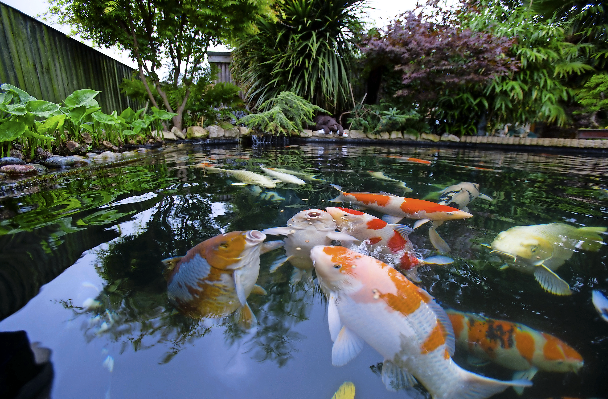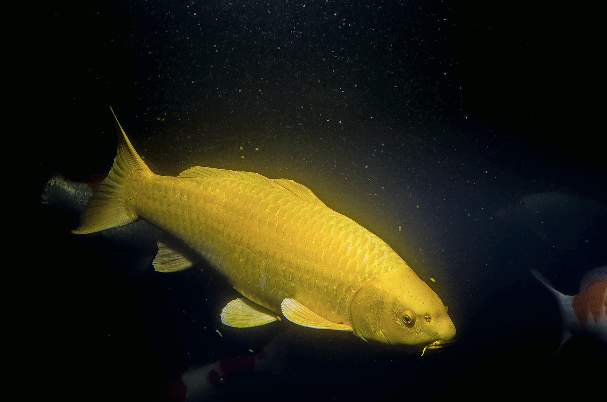Your ponds: Kev Green
Even on our visit on a gloomy day, Kev’s fish are a ray of sunshine!
Kev Green doesn’t do small. When he wanted the ultimate Koi pond, he built the ultimate Koi pond.
WORDS: NATHAN HILL

If you want to see an example of polarisation in aquatics, look outdoors, to the ponds. There was a time when ponds varied wildly, in size and quality. There were the tiny micro-ponds, barely more than glorified puddles, through small medium and large efforts, to customised, intensely-planned domestic oceans.
Somewhere along the way, much of the middle ground has eroded. Primarily, many new ponds now are tiny, more water features than homes for fish, with token species like Shubunkins added as an afterthought, doomed to while away their days until they eventually get plucked by a roaming cat.
At the other end, the large ponds remain. Because big ponds require big filtration, there has always been big money involved. Big money means R&D budgets, technological advances and progress. Visit a large set-up now and you’ll be amazed at how far things have come.

Feeding time for the Koi brings excited mouths begging.
That’s how I felt when I visited Kev Green’s Yorkshire home. Set in modest surroundings, Kev has built himself little short of a swimming pool. At six and a half feet deep, and containing 11,800 gal, this is one of the bigger hand-made pools you’ll come across. Putting things into perspective, that’s 54,000 l — 54 tonnes — of water.
The pool has been in place for 13 years, the culmination of various evolutionary steps. Once upon a time, Kev built a pond, and tore it down on the same day to make something bigger.
But it’s not just the pond that makes the set up so exceptional. The filter has a custom built house of its own. The filter house contains yet another pond; a quarantine set- up that’s still bigger than most peoples’ ‘main’ ponds. There’s a whole Koi culture going on the moment you step into Kev’s garden, from the Bonsai trees that surround it, to the simple Koi posters and Koi shaped clocks on the wall.
Then there are the fish. Kev was reluctant to give me hard numbers, but what I did wangle out of him was eye-opening. Out of courtesy, I’m not giving you a value, but it turns out that an 80cm/32in, top grade, Japanese imported Koi is a bit pricier than I’d imagined it to be.

It was only when Kev’s son, Aidan, came out to handfeed some of the fish that the sense of scale really hit home. Koi have a carp ancestry but looking at the beasts swimming around this Yorkshire garden, you’re inclined to wonder if any Whale shark genes have slipped in along the line…

What’s the appeal of Koi ponds over aquaria for you?
Koi ponds are much more relaxing and the fish themselves are just majestic things to watch. In the open-air atmosphere of the garden it all makes for very laid back viewing. On the downside, keeping Koi does soon become very addictive and costly…
What was the most difficult part about building your pond?
The manual labour was exhausting. It was dug by hand so all soil had to be moved by wheelbarrow around the house and into skips out front.


The filter and quarantine has its own ‘house.’
What filtration do you use?
To start with, there are two aerated bottom drains, one side drain and surface skimmer acting as the exit points for pond water. All of these feed into a ProfiDrum Eco 65 drum filter. From here there are two pumps — the first is a FlowFriend model which feeds into the tops of two 1.5m long, four-tier double bakki showers filled with Bacteria House Media (BHM).
The water then runs through one of four separate channels. One of these diverts through a 1500mm long, 400mm wide, 800mm high stainless steel tank which utilises a 130 lpm (litres per minute) air pump to relentlessly churn over more than 300 l of Kaldnes K1 biomedia.
A second pump is a Blue Eco which pushes water through a 108W Bio UV 40, followed by a 19.5kW heating pump unit. It then travels back to the pond and is delivered through a combination of one return and a waterfall. On each of the bottom drains there’s an airstone powered by a 60 lpm blower.
For someone who doesn’t know, how does a bakki shower work?
The media in a bakki shower is BHM; a highly porous, intense heat-treated man-made material. It has an incredible surface area to volume ratio that both aerobic and anaerobic bacteria can live in. Because it can cater for both, this type of media also helps reduce nitrate as well as ammonia and nitrites. The action of the water crashing through the four layers of media — the underlying design of a bakki shower — in the four-tier shower helps to ‘gas off’ harmful compounds as well as aerating water.
What kind of maintenance does the filtration need?
There’s hardly any maintenance at all. The skimmer filter grid requires a regular clear out, and probably once a week I’ll give the drainage pipes a powerful flush from the drum filter. Approximately every six months I’ll clean the filter screen on the drum filter with acid, and when moss builds up too much and starts to choke the waterfall I’ll clear it off. That’s about it.
How do you go about water changing something of this size?
Water changing is always ongoing. There’s a constant trickle of inflow which overflows waste water to a built-in drain.

How do you go about health checking the fish?
Health checks are something I try and perform regularly. Visually checking over the fish is probably the most important task, and I can usually tell if a problem is looming. Visual checks let me see if any fish have physically damaged themselves, and the viewing window is great for facilitating this.
If I suspect parasites or just want peace of mind, I’ll carry out some skin scrapes and look under a microscope to see what’s there. Any parasite can be an indication of trouble.
In the event of a problem, what are your preferred medications? Do you rate salt as a pond treatment?
There are numerous treatment options, pending the problem being addressed. I use Chloramine T for any bad bacterial outbreaks, as well as Colombo’s Alparex for parasite and fungal issues.
Colombo’s FMC-50 is my choice against white spot and as a tonic, I love salt. Salt helps Koi to recovery in many ways. Acriflavine or Potassium Permanganate works well against Costia or Trichodina, and many more. Antibiotics may be needed for some issues, but it’s a contentious subject as what might work for one aquarist won’t necessarily work for everyone.
Do you regulate the pond temperature? How important is it to avoid fluctuations?
I always regulate the temperature at those times of year that it’s warming or cooling. I believe a stable temperature is preferred by the Koi, and in winter I’ll not let the pond drop down below 12°C/54°F.
What’s the illness you fear the most?
The worst illness I fear is the same I think that all Koi keepers fear — KHV (or Cyprinid herpesvirus, CyHV-3)
How old is your oldest fish?
The oldest Koi I have is now 15 years old, but I do have a Mirror carp which is now in excess of 20 years.

To our eyes, your selection is very traditional. Do you have particular varieties that you rally to?
The collection is mostly Gosanke oriented, but with plenty of Ogons too. A pleasant variety of colours is the only goal I have, really.
Do you just collect Koi, or do you ever sell any on as well?
I’m always buying in new Koi and selling others on. I also like to grow some on in my quarantine facility, to maybe get the occasional nice one.
Is Japan still ‘the’ place for Koi?
In my mind Japan is way ahead of any other country in terms of Koi quality, although you will always get the odd exception out there. A high-end Koi is determined by many factors, including but not limited to age, size, adeptness of the breeder involved, and more. The main criteria to look for are skin quality, coloration, body shape, scalation and pattern.

What food do your fish get, and at what frequency? Do you change the foods throughout the year to cater for growth?
Throughout winter my Koi get a mixture of off-the-shelf wheatgearm, staple and health foods, but with treats like pearl barley and mussels thrown in.
Through the summer I’m interested in growth and colour-enhancing foods, but again with treats like pearl barley, mussels, lettuce, maggots, and silkworm pupae.
The food may vary pending requirements — specifically, if there’s a show coming up, or if I identify a health issue.

Kev's quarantine area is bigger than many people's ponds!
What size is your quarantine facility?
My quarantine tank (which sits in a purpose built ‘Koi house’) is 7250 l/1600 gal and filtered just like the main pond, using a drum filter, bakki shower, UV, and heat pump.
How I quarantine any new arrivals depends on their origins — whether they’ve come from Japan, a UK-based dealer or a private pond. If I do need to quarantine a fish, then it’ll receive a course of treatments, and I’ll elevate temperatures for four to six weeks while it undergoes observation.
What’s the biggest mistake made by newcomers to the Koi scene?
That’s easy: inadequate filtration and poor circulation.
If you could go back and do one thing differently with your pond, what would it be?
Ha! I guess I’d build in more windows, but if I could go back now I’d probably not keep fish at all and have all the money to spend instead!
Meet the aquarist
Name: Kev Green.
Age: 50.
Occupation: Plumber, tiler and kitchen fitter.
Time in the hobby: I’ve been keeping Koi for 27 years, but I’ve had some form of fish around since I was 12.
Favourite fish: The Tancho has always been my favourite fish, but I have a thing for large Koi.
Dream fish: My dream would be to own a Koi in excess of 110cm/44in long.

Fast facts
Number of Koi in the main pond: 44.
Three bits of kit Kev wouldn’t be without: Drum filter, good Koi net, microscope.
Amount of salt used per dose: About 167kg.
Favourite pond gear brand: ProfiDrum.
Number of Koi nets: 11, plus handling socks and bowls.
See the video!
Check out more of Kev's fish below...







